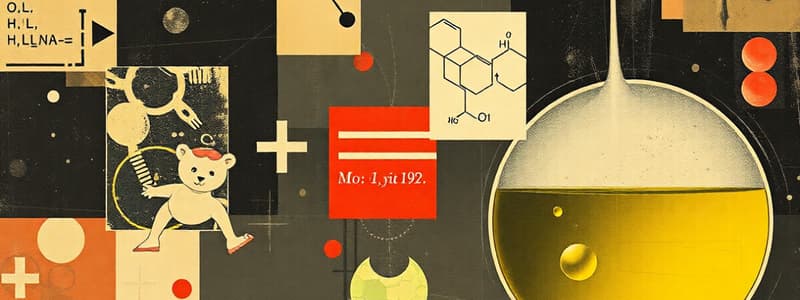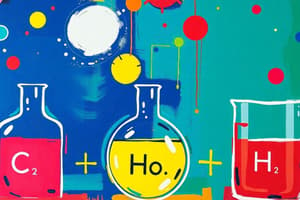Podcast
Questions and Answers
What defines a limiting reactant in a chemical reaction?
What defines a limiting reactant in a chemical reaction?
- It is the reactant that limits the reaction. (correct)
- It is the reactant that participates in side reactions.
- It is the substance formed during the reaction.
- It is the reactant that is present in excess.
Which statement regarding excess reactants is true?
Which statement regarding excess reactants is true?
- Excess reactants do not contribute to the formation of products.
- Excess reactants can limit the yield of a product.
- Excess reactants are always consumed completely in the reaction.
- Excess reactants are present in greater quantities than limiting reactants. (correct)
What is the theoretical yield in a chemical reaction?
What is the theoretical yield in a chemical reaction?
- The actual amount of product obtained from the reaction.
- The ratio of actual yield to theoretical yield.
- The actual yield adjusted for impurities.
- The maximum amount of product that can be produced from given reactants. (correct)
How is percentage yield calculated?
How is percentage yield calculated?
When might the experimental yield be lower than the theoretical yield?
When might the experimental yield be lower than the theoretical yield?
In a reaction, if the actual yield is 2.5 grams and the theoretical yield is 5 grams, what is the percentage yield?
In a reaction, if the actual yield is 2.5 grams and the theoretical yield is 5 grams, what is the percentage yield?
Which formula represents the calculation of percentage yield?
Which formula represents the calculation of percentage yield?
What is a product in a chemical reaction?
What is a product in a chemical reaction?
What is the number of moles of NaCl used in the reaction?
What is the number of moles of NaCl used in the reaction?
How much aluminum (Al) is left over after the reaction?
How much aluminum (Al) is left over after the reaction?
What is the limiting reactant in this chemical reaction?
What is the limiting reactant in this chemical reaction?
What is the total molar mass of AlCl3?
What is the total molar mass of AlCl3?
How many grams of AlCl3 are formed in the reaction?
How many grams of AlCl3 are formed in the reaction?
Which calculation is performed to find the number of moles of Al?
Which calculation is performed to find the number of moles of Al?
What is the relationship between the amount of moles of NaCl and AlCl3 produced?
What is the relationship between the amount of moles of NaCl and AlCl3 produced?
What would increase the amount of AlCl3 produced?
What would increase the amount of AlCl3 produced?
Which of the following statements is true regarding the calculation of limiting reactants?
Which of the following statements is true regarding the calculation of limiting reactants?
What does the law of conservation of matter state?
What does the law of conservation of matter state?
In the equation 4NH3 + 3O2 = 2N2 + 6H2O, how many moles of O2 are required to react with 8 moles of NH3?
In the equation 4NH3 + 3O2 = 2N2 + 6H2O, how many moles of O2 are required to react with 8 moles of NH3?
Which of the following best describes a limiting reagent?
Which of the following best describes a limiting reagent?
What is the purpose of a balanced chemical equation?
What is the purpose of a balanced chemical equation?
What is percent yield?
What is percent yield?
In a mole-to-mole conversion, which factor is used to determine the number of moles of a reactant?
In a mole-to-mole conversion, which factor is used to determine the number of moles of a reactant?
Which of the following is true about excess reagents?
Which of the following is true about excess reagents?
How many moles of NH3 are present if 12 moles of O2 react according to the equation 4NH3 + 3O2 = 2N2 + 6H2O?
How many moles of NH3 are present if 12 moles of O2 react according to the equation 4NH3 + 3O2 = 2N2 + 6H2O?
What unit is most commonly used to measure reactants or products in a laboratory?
What unit is most commonly used to measure reactants or products in a laboratory?
What is required to convert moles to grams?
What is required to convert moles to grams?
How many moles of O2 are needed to react with 8 moles of NH3 according to the balanced chemical equation?
How many moles of O2 are needed to react with 8 moles of NH3 according to the balanced chemical equation?
What is the molar mass of O2 from the given information?
What is the molar mass of O2 from the given information?
Which of the following steps involves changing grams of NH3 to moles?
Which of the following steps involves changing grams of NH3 to moles?
In the reaction involving NH3 and O2, how many grams of O2 are needed to react with 250 g of NH3?
In the reaction involving NH3 and O2, how many grams of O2 are needed to react with 250 g of NH3?
What is the first step in solving a mass-to-mass conversion problem?
What is the first step in solving a mass-to-mass conversion problem?
Which conversion factor is used to relate NH3 to O2 in the reaction?
Which conversion factor is used to relate NH3 to O2 in the reaction?
To find the reactants that produce the maximum quantity of products at minimum cost, what is essential?
To find the reactants that produce the maximum quantity of products at minimum cost, what is essential?
When converting moles to grams, what is the last step?
When converting moles to grams, what is the last step?
What does 15.9 u represent in this context?
What does 15.9 u represent in this context?
If 250 g of NH3 are used, how many grams of O2 can be produced?
If 250 g of NH3 are used, how many grams of O2 can be produced?
What happens to the number of moles of O2 when moles of NH3 are increased?
What happens to the number of moles of O2 when moles of NH3 are increased?
What is the purpose of using a balanced chemical equation in mole-to-mass conversions?
What is the purpose of using a balanced chemical equation in mole-to-mass conversions?
Flashcards
Conservation of Matter
Conservation of Matter
The principle that the total amount of matter remains constant during a chemical reaction.
Mole-to-Mole Conversion
Mole-to-Mole Conversion
Using the ratio of moles between substances in a balanced chemical equation to determine the number of moles of one substance given the moles of another.
Balanced Chemical Equation
Balanced Chemical Equation
A chemical equation representing a reaction with equal numbers of atoms of each element on both sides of the equation.
Conversion Factor
Conversion Factor
Signup and view all the flashcards
Limiting Reactant
Limiting Reactant
Signup and view all the flashcards
Excess Reactant
Excess Reactant
Signup and view all the flashcards
Mole
Mole
Signup and view all the flashcards
Theoretical Yield
Theoretical Yield
Signup and view all the flashcards
Percent Yield
Percent Yield
Signup and view all the flashcards
Mole-to-Mass Conversion
Mole-to-Mass Conversion
Signup and view all the flashcards
Molar Mass
Molar Mass
Signup and view all the flashcards
Mole Ratio
Mole Ratio
Signup and view all the flashcards
Unit Analysis
Unit Analysis
Signup and view all the flashcards
Reactant
Reactant
Signup and view all the flashcards
Product
Product
Signup and view all the flashcards
Chemical Equation
Chemical Equation
Signup and view all the flashcards
Coefficient
Coefficient
Signup and view all the flashcards
Atomic Mass
Atomic Mass
Signup and view all the flashcards
Molecular Mass
Molecular Mass
Signup and view all the flashcards
Chemical Formula
Chemical Formula
Signup and view all the flashcards
Actual Yield
Actual Yield
Signup and view all the flashcards
How to determine the limiting reactant?
How to determine the limiting reactant?
Signup and view all the flashcards
How to calculate the excess reactant?
How to calculate the excess reactant?
Signup and view all the flashcards
How to calculate the theoretical yield?
How to calculate the theoretical yield?
Signup and view all the flashcards
How to identify the limiting reactant?
How to identify the limiting reactant?
Signup and view all the flashcards
Calculating excess reactant
Calculating excess reactant
Signup and view all the flashcards
Calculating product yield
Calculating product yield
Signup and view all the flashcards
What is stoichiometry?
What is stoichiometry?
Signup and view all the flashcards
Gram-to-Mole Conversion
Gram-to-Mole Conversion
Signup and view all the flashcards
Study Notes
Conservation of Matter
- Chemical equations are useful for interpreting chemical reactions.
- Students will learn how to calculate percent yield and theoretical yield.
- Students will learn to identify limiting and excess reagents.
- The law of conservation of mass (or matter) states that the amount of matter before and after a reaction remains the same.
Mole-to-Mole Conversion
- The number of moles of a substance in a chemical reaction can be determined if the number of moles of another substance is known.
- Mole conversion factors are based on the coefficients in a balanced chemical equation.
- Example: 4NH₃ + 3O₂ → 2N₂ + 6H₂O
Mole-to-Mass Conversion
- Grams are a convenient unit for measuring reactants and products in a lab.
- To convert between moles and grams, use the molar mass of the substance.
- Example: How many grams of O₂ are needed to react with 8 moles of NH₃?
Mass-to-Mass Conversion
- This conversion is used when the mass of one substance is known, and the mass of another substance is needed.
- Example: How many grams of O₂ are needed to react with 250 g of NH₃?
Reaction Yield
- Theoretical yield: maximum amount of product possible.
- Actual yield: amount of product obtained in a lab.
- Percentage yield: efficiency of a reaction, calculated as (actual yield / theoretical yield) * 100.
- Limiting reactant: reactant that limits the amount of product.
- Excess reactant: reactant present in excess of the limiting reactant.
Studying That Suits You
Use AI to generate personalized quizzes and flashcards to suit your learning preferences.




